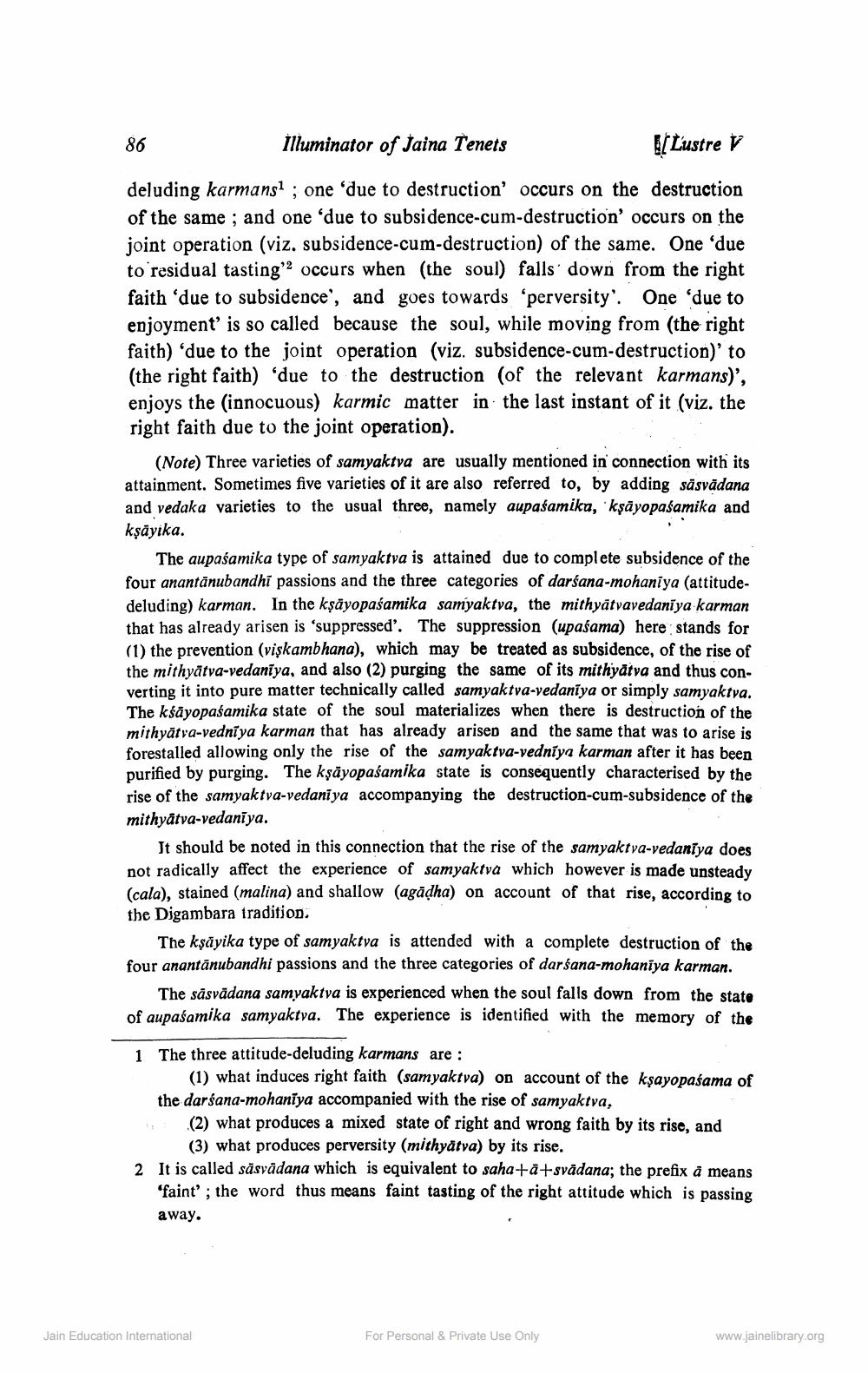________________
86
İlluminator of Jaina Tenets
(Lustre V
deluding karmansl ; one due to destruction occurs on the destruction of the same ; and one 'due to subsidence-cum-destruction' occurs on the joint operation (viz. subsidence-cum-destruction) of the same. One 'due to residual tasting' occurs when (the soul) falls down from the right faith due to subsidence', and goes towards 'perversity'. One due to enjoyment is so called because the soul, while moving from (the right faith) 'due to the joint operation (viz. subsidence-cum-destruction' to (the right faith) 'due to the destruction (of the relevant karmans)', enjoys the innocuous) karmic matter in the last instant of it (viz. the right faith due to the joint operation).
(Note) Three varieties of samyaktva are usually mentioned in connection with its attainment. Sometimes five varieties of it are also referred to, by adding sāsvādana and vedaka varieties to the usual three, namely aupaśamika, kṣāyopaśamika and kṣāyika.
The aupaśamika type of samyaktva is attained due to complete subsidence of the four anantānubandhi passions and the three categories of darśana-mohaniya (attitudedeluding) karman. In the kṣāyopaśamika samyaktva, the mithyatvavedaniya karman that has already arisen is 'suppressed'. The suppression (upaśama) here stands for (1) the prevention (viskambhana), which may be treated as subsidence, of the rise of the mithyātva-vedanīya, and also (2) purging the same of its mithyātva and thus converting it into pure matter technically called samyaktva-vedaniya or simply samyaktva. The kśāyopaśamika state of the soul materializes when there is destruction of the mithyātva-vedniya karman that has already arised and the same that was to arise is forestalled allowing only the rise of the samyaktva-vednīya karman after it has been purified by purging. The kşāyopaśamika state is consequently characterised by the rise of the samyaktva-vedaniya accompanying the destruction-cum-subsidence of the mithyatva-vedanīya.
It should be noted in this connection that the rise of the samyaktva-vedaniya does not radically affect the experience of samyaktva which however is made unsteady (cala), stained (malina) and shallow (agādha) on account of that rise, according to the Digambara tradition.
The kşāyika type of samyaktva is attended with a complete destruction of the four anantānubandhi passions and the three categories of darśana-mohanīya karman.
The sāsvādana samyaktya is experienced when the soul falls down from the state of aupaśamika samyaktva. The experience is identified with the memory of the
1
The three attitude-deluding karmans are :
(1) what induces right faith (samyaktva) on account of the kşayopasama of the darśana-mohaniya accompanied with the rise of samyaktva,
(2) what produces a mixed state of right and wrong faith by its rise, and
(3) what produces perversity (mithyätva) by its rise. It is called sāsvādana which is equivalent to saha+a+svādana; the prefix à means 'faint'; the word thus means faint tasting of the right attitude which is passing away.
2
Jain Education International
For Personal & Private Use Only
www.jainelibrary.org




